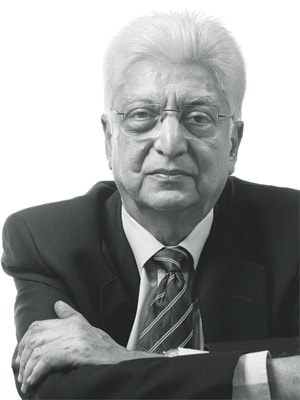
Behind The Czar's Decree - What's Happening At Wipro
Wipro failed to call the rebound in the global economy and underperformed its rivals in software outsourcing. Azim Premji held the co-CEO model responsible
Nothing had prepared the 30-odd senior-most executives at Wipro Technologies for what they were about to hear. They had been asked to come for a meeting with the joint CEOs at 8 a.m. on January 21. When they arrived at Wipro’s campus at Electronic City, Bangalore, it soon became apparent that this wasn’t just another review meeting. They were split into two rooms, depending on which CEO they reported to. And then, Girish Paranjpe and Suresh Vaswani, both lifers at Wipro, broke the news: They were quitting.
There was stunned silence. And then questions began to come thick and fast: Why were they quitting? Some people even offered to resign, saying that they had let down their bosses. Paranjpe and Vaswani then switched rooms and did the same routine all over again. By which time, it had become apparent that the format wasn’t working. So they brought everyone together into one room. Emotions were running high. Several executives, including Vaswani, had tears in their eyes.
It was an awkward end to a three-year-old experiment which was put in place by Azim Premji himself because he felt the IT business was too complex to be run by one CEO.
But the die had been cast six months ago, say insiders. At a stormy meeting to discuss the second quarter (July to September 2010) results, the directors on the board, led by Azim Premji, chairman and 75 percent owner, had expressed their strong displeasure at the financial performance of the IT business. Since then, Premji himself had kept the pressure on the two leaders through constant performance reviews.
But the pressure hadn’t yielded results. Even for the next quarter, Wipro’s performance continued to lag behind its peers, Infosys and TCS. And if the current momentum continued, even the fourth placed Cognizant would be all set to overtake Wipro in the last quarter (January to March 2011).
“Premji and the board’s view was that execution had badly faltered. There was nothing fundamentally wrong with Wipro’s strategy,” says an insider.
The decision to dismantle the co-CEO model had become inevitable. By common consensus, the model was slowing things down, even as the market had begun to rebound. On January 21, at a press conference at his company headquarter in Bangalore, Premji said, “I don’t think we should be making excuses. We have underperformed relative to competition, and relative to our potential as a company.”
The board could have picked one or the other. But Vaswani and Paranjpe had themselves made it clear that they would both resign, accepting joint responsibility for their performance.
Yet the suddenness of the move, especially Vaswani’s exit, took almost everyone by surprise. Vaswani had been mentored by Premji himself and was known to be very close to the owner. Till the very end, both he and Paranjpe were company men. “Which is why the news of their sacking caused a lot of anxiety and concern among lifers inside the company,” says a senior executive. (Despite repeated attempts, Vaswani and Paranjpe chose not to comment on any issues.)
Enter T.K. Kurien, the man chosen by the board to head the IT business. He is known to be an uncompromising, tough-as-nails manager. He had done stints in General Electric and has strong C-suite relationships at several large global 100 firms. A strong corporate sales guy, Kurien has the experience in sewing up large deals. He had turned around Wipro’s BPO business and delivered results. When Vaswani and Paranjpe were picked to head Wipro, Kurien had offered to resign. In June last year Premji moved him to head the new Eco Energy business.
Yet, inside Wipro, Kurien is still seen as an outsider. He is related by marriage to the owners of the Malayala Manorama group, is already wealthy and the only reason he continues at Wipro is his passion for the work. In Wipro’s senior IT team, there are plenty of people who are uncomfortable with the board’s choice, given Kurien’s penchant for decisive actions.
An insider with knowledge of the workings of the board says it has a simple mandate for Kurien: Do all that it takes to quickly clean up the mess, bet on good people, get rid of some bad ones if you have to — and then go hell for leather for growth. “Once you go through this kind of announcement you are not going to be expecting everybody to be nice and happy, but they need to go back and focus on results,” said Kurien at the press conference.

Image: Girish Paranjape & Suresh Vaswani: Namas Bhojani for Forbes India;T. K. Kurien: G R N Somashekar / Hindubusinessline
Yet, arresting the slide may be easy, but playing catch up with TCS, Infosys and now, Cognizant, will be far from easy. Reversing the decline in performance may well take more than a couple of quarters. Whether the board has the patience to wait for a pickup in performance this time remains to be seen.
By all reckoning, the clean-up job will test Kurien’s mettle. Wipro is caught in a bind. Today, it neither has the industry-leading operating margins that Infosys or TCS delivers, nor is it able to match Cognizant’s ability to deliver 38 percent top-line growth, albeit at much lower operating margins. “TCS and Infosys have been able to master the outsourcing game. We’ve struggled to hire rookies on that scale and train them to be job-ready,” admits a senior Wipro manager.
When the recession struck towards the end of 2008, Wipro dramatically pared down the size of its bench, cut back on expenses and focussed on productivity growth. The instructions to tighten the nuts came directly from the board — and Vaswani and Paranjpe took up the task. Wipro pulled the plug on campus recruitments. The restructuring exercise did deliver results — Wipro was able to withstand the crisis with its margins intact — but it had its fallout on staff morale.
So when the market picked up, attrition began to mount alarmingly. Almost one in five employees quit during April to December 2010. “We had to hire talent laterally at a much higher cost to fill up gaps. And we were also unable to source the top 10 percent engineers from campuses because [we were] no longer offered a slot on day one [of] placements,” says a senior executive. (Pratik Kumar, head of HR, says attrition is high for everyone and Wipro’s numbers are in line with its peers.)
“Our reading of how long the recession would last was wrong… When we went into it, we thought it would last 18-24 months. We planned accordingly,” says a senior executive. Also, Wipro tended to over-correct itself. “So we were the first off the blocks to cut costs and we did it too aggressively. We executed too perfectly for the slowdown,” says the same executive.
Similarly, it made a wrong call on the upturn — and ended up missing much of the rebound in the financial services and healthcare verticals. Telecom and engineering services were Wipro’s strengths. But the telecom growth markets had shifted to emerging markets in Asia and Africa, and it meant working off a new delivery model.
Finally, the large deals, which would have helped push up margins, simply weren’t coming through. So while TCS had at least nine $100 million-plus clients, Infosys had 11 and Wipro, only one.
Before Wipro announced its second quarter results, there was a feeling inside that its performance would be on par with its peers. But when Infosys and TCS put out their numbers, there was complete shock. The duo had actually managed to increase their margins and also grown their top-line at a faster clip, even as Wipro’s operating margins had slid to 22 percent.
The board was up in arms. Some of the directors were cut up that the co-CEOs were unable to build consensus in committing greater resources to emerging markets. “We were also concerned that despite an iconic leader like Azim Premji, we weren’t adequately using him to open doors at large global firms,” says an independent director, on conditions of anonymity.
Now, the co-chief structure demanded consensual decision-making. It worked fine during the recession, when everyone was focussed internally. When the markets turned, things started happening a lot more quickly. The two CEOs were constantly travelling, meeting their clients and it just became more difficult to get joint meetings and calls. All this started holding up decisions.
Typically, Wipro plans its internal strategy exercise between October and December and kicks off its operational plans from January, after the board conducts a review in January. In normal course, a new leader would have taken over from April. But since Kurien was coming in from the Eco Energy business, the board chose to put him in charge of operations from January itself. The co-CEOs will stay on till the end of March 2011 to help Kurien with the transition.
By the time you read this, Kurien would have hit the ground running. Along with Premji, he will be replacing Vaswani and Paranjpe, who were expected to be at the World Economic Forum at Davos, networking with clients, hosting dinners and hopefully, stuffing Wipro’s deal pipeline with some large orders.
(Additional reporting by N.S. Ramnath)
(This story appears in the 30 November, -0001 issue of Forbes India. To visit our Archives, click here.)





